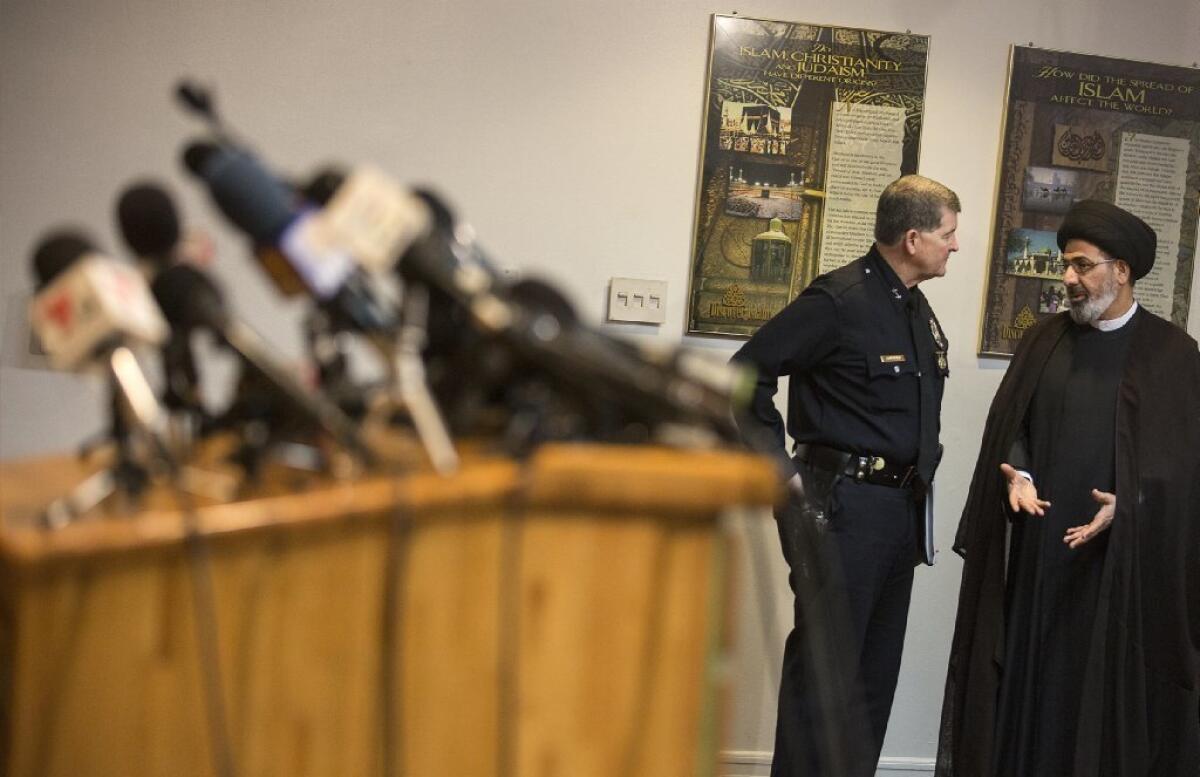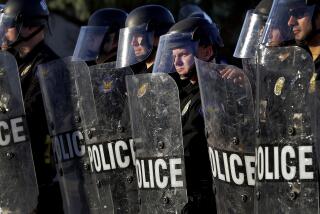The fine line for police between a ‘hate crime’ and a ‘hate incident’

When he first read the letter mailed to the Islamic Center of Long Beach last November, Tarek Mohamed wasn’t terribly surprised by the hateful screed inside.
The note was addressed to the “Children of Satan,” called for the extermination of Muslims in the U.S. and referenced Donald Trump’s election night victory. But Mohamed, the center’s president, had received similar messages before, and knew he would again.
Authorities examined the letter — and ones sent to other Islamic institutions in California — and quickly determined it didn’t rise to the level of a hate crime that could be prosecuted.
But in a increasingly common move, police officials classified the letter as a “hate incident” and, working with the U.S. Postal Service, began a search for the author.
Typically, the standard for a police investigation focuses on whether a crime has occurred. But as police departments across the nation deal with sensitivities about about hateful and threatening speech, they are trying to get ahead of the issue.
Police are encouraging citizens to report any and all bias-motivated incidents, from simple verbal attacks to overt crimes. And detectives are investigating even when the reports don’t amount to a crime.
Investigators say that information can help them prevent hate crimes or build evidence against someone who goes on to commit a crime. But it also forces police to walk a fine line, probing without infringing on the free speech rights of those they investigate.
“People have a right to say what they want. No matter how bad it is and how hurtful it is to other people,” said Los Angeles Sheriff’s Department Det. Chris Keeling, a veteran hate crimes investigator. “We have to know those people are out there, but what we have to fight against is allowing that person’s statement to cause us to react in a negative way.”
The perceived rise in bias actions has been a source of intense debate across the country ever since Trump rose to the front of a crowded field of GOP candidates last year, and some critics believe his ascension to the presidency has emboldened those who hold anti-Muslim or white supremacist views.
Officials said they don’t know whether there are actually more hate crimes since the election or whether they are simply getting more attention. But FBI statistics show reported hate crimes throughout the U.S. rose 7% in 2015.
Police across California said they developed strategies for dealing with hate incidents long before Trump’s election, something they said was a necessity in the diverse communities they serve.
There is a difference between a hate crime and cruel or hurtful comments, many of which are protected under the 1st Amendment. The law makes it illegal to physically harm someone based on his or her race, religion, national origin, gender or sexual orientation, among other characteristics.
Hate incidents are a different matter. A person on receiving end of a hateful email or racist rant can feel attacked, but police say many of these encounters don’t amount to a crime.
Some police agencies have been taking down information about both the victims of hate incidents and the offending party. Officials say it’s similar to the way they catalog information to calls for service.
Such incidents will often be referred to a department’s hate crimes unit, but not entered into a central database tracking those who engage in hate speech, according to Los Angeles Police Cmdr. Horace Frank, assistant commanding officer of the department’s counterterrorism and special operations bureau.
Frank said believes having the information on file could be helpful in preventing future hate crimes — or at least help with those investigations.
“Incidents quite often develop into crimes,” he said. “The last thing we want to do is to be on the responsive end as opposed to the preventive end.”
The LAPD will go to great lengths to identify the perpetrator of a hate incident, even if no crime has been committed, Frank added. In some instances investigators have used partial license plates or even DNA to track down potential suspects, though those tactics are more normally used in the investigation of an actual hate crime, he said.
Hate in general is like a bubbling volcano. Once it erupts it’s already too late.
— Nolan Lebovitz, rabbi at Adat Shalom in Los Angeles
Still, there’s only so much police can do without evidence of an actual crime. Sgt. Daron Wyatt, an Anaheim police spokesman, said his department aggressively investigates and tracks information on hate incidents, and they will often try to make contact with people engaged in such behavior. But they can’t even have a conversation with the offending party without consent.
“If we walk up to someone and say hello … and they say ‘I’m not talking and I’m walking away,’ then we have to let them walk away,” he said.
Peter Bibring, director of police practice for the American Civil Liberties Union in Southern California, said there’s nothing wrong with police collecting information when they receive reports about possible bias crimes. But he cautioned law enforcement against going a step further and creating specific pools of information regarding people involved in hateful speech, the way they might track those involved in gang activity or other classes of crimes.
“They can go out and ask questions to make sure that there’s nothing more serious involved, but they shouldn’t maintain information about people unless there’s reasonable suspicion to believe they’re involved in criminal activity,” he said. “They certainly shouldn’t maintain information about people just because of their political viewpoints, repugnant though they may be.”
Fears that the election might embolden some to commit racially motivated attacks have been stoked by violent assaults in California and elsewhere in the past few weeks.
Last month in Simi Valley, two men hurled racial slurs at a group of people who had just left an Islamic prayer service. While that on its own might have been considered a hate incident, the clash quickly turned physical. One of the mosque attendees was stabbed, and police have labeled the attack as a hate crime.
On Thursday, four people were charged with a hate crime in Chicago after they kidnapped, pummeled and slashed a mentally disabled 18-year-old and broadcast the attack on social media. The suspects, who were black, repeatedly shouted profanities about white people and Trump. The victim was white, according to the video of the assault.
The heightened sensitivity to hate and concerns over potential 1st Amendment abuses have made partnerships between police and advocacy groups that focus on bias more important than ever, officials said. In recent weeks, the Los Angeles city attorney’s office has been discussing hate incidents and crimes with the Anti-Defamation League, and the Sheriff’s Department has a long established relationship with the league, officials said.
Unlike police, the Anti-Defamation League, as a private organization, has more latitude in the types of information it can document, said Oren Segal, director of the agency’s Center On Extremism.
“As a non-governmental organization who tracks extremists and hatred, I don’t need to get permission to monitor somebody’s public statements and their social media account, or if they attend a rally, to collect information,” he said. “We’re allowed to collect that information … and we’re allowed to share it with law enforcement.”
While investigators’ primary focus in tracking hate incidents might be to collect data and observe trends in extremist behavior, Segal said law enforcement’s serious approach to such activity can also help act as a balm for a victimized community.
“Having law enforcement not only take it seriously and document it, but for them to reach out to victims and let them know we’re not going to forget about you, goes a long way,” he said.
Keeling said the tough stance on hate incidents might cause someone to think twice about committing a bias-motivated crime later on. If a person is the subject of multiple hate incident reports, Keeling said, he or she might get a visit from investigators, something the sheriff’s detective hopes acts as a deterrent.
“If I have a series of reports, and the same name keeps coming up, at some point, as a detective I am going to make contact with that person. But when I contact, it’s not always to make an arrest. Sometimes I contact you for intervention, prevention,” he said. “I’m trying to keep you from rising to the level and crossing that threshold of a crime.”
The aggressive stance from police has been welcomed by some of the communities that are most likely to be the targets of hate speech. Nolan Lebovitz, the rabbi at Adat Shalom in Los Angeles, said a quick response from the LAPD helped calm members of his synagogue after someone spray painted the word “Nazi” on the building in March.
“Whether or not it’s officially a crime, hate is something that needs to be addressed seriously,” he said. “Hate in general is like a bubbling volcano. Once it erupts it’s already too late.”
Interested in the stories shaping California? Sign up for the free Essential California newsletter »
For others who have been targeted, the distinction between a hate crime and a hate incident doesn’t mean much. Mohamed doesn’t care what term police use to describe the hateful letters sent to California mosques, as long as detectives identify the author and make sure he or she doesn’t present a larger threat.
“We don’t want to wake with a bloodshed in Southern California, because this letter doesn’t meet the criteria of criminal action,” he said.
Follow @JamesQueallyLAT for crime and police news in California.
ALSO
Cops are going undercover and watching social media to combat hate crimes
LAPD investigate anti-gay vandalism as hate crime at Van Nuys home
More than 1,200 homeless veterans living on Los Angeles streets still need housing
As Inauguration Day nears, Muslims wonder whether Trump’s tough talk will turn into action
More to Read
Sign up for Essential California
The most important California stories and recommendations in your inbox every morning.
You may occasionally receive promotional content from the Los Angeles Times.










